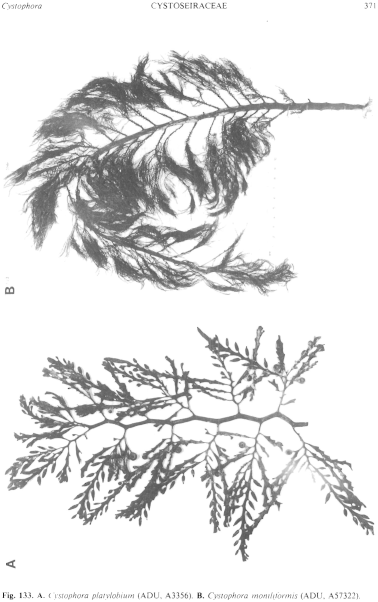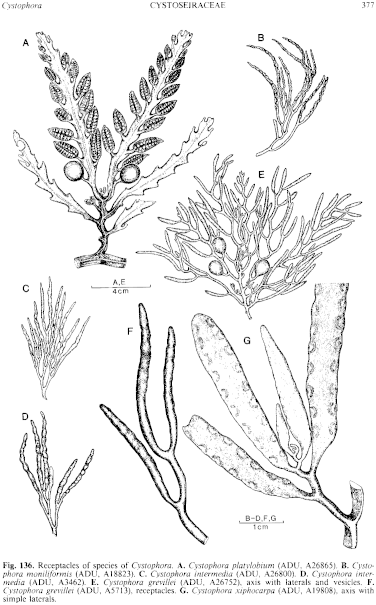|
|
|
|
|
|||||||||||
|
Electronic Flora of South Australia Species Fact Sheet
Phylum Phaeophyta – Order Fucales – Family Cystoseiraceae
Selected citations: Nizamuddin 1964c: 42–63.
Synonyms
Fucus moniliformis Esper 1804: 80, pl. 148.
Fucus spartioides Turner 1819: 86, pl. 232.
Cystophora spartioides (Turner) J. Agardh 1848: 244. Harvey 1859a, pl. 76.
Thallus (Fig. 133B) dark brown (often medium brown near apices), 0.5–2 (–4) m long, with robust axes and fastigiate laterals. Holdfast discoid-conical, 0.5–2 (–3) cm across, with a single, terete to compressed stipe 0.5–2 cm long and 2–8 mm in diameter; epilithic. Primary axis strongly compressed, (0.3–) 0.5–1.5 (–2) cm broad and 2–3 (–7) mm thick centrally, usually relatively straight, alternately distichously branched from the edges; secondary axes 2–20 (–100) cm long, occasionally developing into long axes, similarly branched to the primary axes; smaller tertiary axes often present. Laterals fasciculate, much branched alternately, essentially in one plane but with the ramuli becoming displaced, with slender, terete, much branched ramuli 0.2–0.5 mm in diameter; laterals usually lost below, with stubby, rounded, branch residues. Vesicles absent.
Reproduction: Thalli monoecious. Receptacles (Fig. 136B) simple or branched, 0.5–1.5 (–4) cm long and 0.5–1 mm in diameter, moniliform-torulose when fresh, drying strongly moniliform. Conceptacles bisexual, adjacent, with ostioles scattered or tending to two rows; oogonia sessile, ovoid, 80–120 µm long and 60–80 µm in diameter; antheridia sessile or on branched paraphyses, elongate ovoid, 25–35 µm long and 10–16 µm in diameter.
Type from the "south seas" (south coast of Australia) (R. Brown); holotype in ER.
Selected specimens: Meelup, Cape Naturaliste, W. Aust., upper sublittoral (Mitchell, 23.ix.1966; ADU, A31167). Lucky Bay, Cape Le Grand, W. Aust., upper sublittoral ( Womersley, 4.x.1979; ADU, A51147). Cape Carnot, S. Aust., upper sublittoral pools (Womersley, 8.i.1951; ADU, A13817). Between Hopkins and Thistle Is, S. Aust., 6–10 m deep (Baldock, 1.i.1964; ADU, A27132). Second Valley, S. Aust., upper sublittoral (Womersley, 7.xii.1946; ADU, A4520). Vivonne Bay, Kangaroo I., S. Aust., sublittoral fringe (Womersley, 4.i.1950; ADU, Al2763). Robe, S. Aust., upper sublittoral pools, outer coast ( Womersley, 16.xii.1986; ADU, A57322-"Marine Algae of southern Australia" No. 280). Lady Julia Percy I., Vic., 5–8 m deep (Shepherd, 3.i.1968; ADU, A32389). Sorrento, Vic., upper sublittoral (Womersley, 2.vi.1953; ADU, A18823). Low Head Tas., 2–12 m deep (Perrin, Sept. 1948; ADU, A9328). Great Taylor Bay, Bruny I., Tas., 2–7 m deep (Shepherd, 7.ii.1970; ADU, A35553). Cronulla, N.S.W., upper sublittoral (Levring, 16.xi.1947; ADU, A56074). Port Stephens, N.S.W. (May 1939, p. 204).
Distribution: From Cape Naturaliste, W. Aust. around southern Australia and Tasmania to Port Stephens, N.S.W. Lord Howe I.
Taxonomic notes: C. moniliformis is one of the largest and most distinctive species of Cystophora, with the flat axes and much-branched fascicles of terete ramuli from the edges. It is often common (1–4 m deep) with moderate to strong water movement; on rough-water coasts it is confined to rock pools or areas with slight shelter, extending to 28 m deep.
The two specimens from Yallingup, W. Aust. referred to in Womersley (1964, p. 72) are now placed in C. harveyi. The specimen from Meelup, W. Aust. has a relatively narrow primary axis, approaching that of the eastern C. intermedia.
References:
AGARDH, J.G. (1848). Species, Genera et Ordines Algarum. Vol. 1. (Gleerup: Lund.)
ESPER, E.J.C. (1804). Icones Fucorum cum characteribus systematicis, synonymis auctorum et descriptionibus novarum specierum. 6, 53–101, Plates 136–157. (Nuremburg.)
HARVEY, W.H. (1859a). Phycologia Australica. Vol. 2, Plates 61–120. (Reeve: London.)
NIZAMUDDIN, M. (1964c). The anatomy and life history of Cystophora, Acrocarpia and Caulocystis (Fucales). Bot. Mar. 7, 42–63.
TURNER, D. (1819). Fuci sive Plantarum Fucorum Generi a Botanicis Ascriptarum Icones Descriptiones et Historia. Vol. 4, pp. 1–153, Plates 197–258. (London.)
WOMERSLEY, H.B.S. (1964). The morphology and taxonomy of Cystophora and related genera (Phaeophyta). Aust. J. Bot. 12, 53–110, Plates 1–16.
The Marine Benthic Flora of Southern Australia Part II complete list of references.
Publication:
Womersley, H.B.S. (14 December, 1987)
The Marine Benthic Flora of Southern Australia
Part II
©Board of the Botanic Gardens and State Herbarium, Government of South Australia
Illustrations in Womersley Part II, 1997: FIGS 133B, 136B.

Figure 133 enlarge
Fig. 133. A. Cystophora platylobium (ADU, A3356). B. Cystophora monihformis (ADU, A57322).

Figure 136 enlarge
Fig. 136. Receptacles of species of Cystophora. A. Cystophora platylobium (ADU, A26865). B. Cystophora moniliformis (ADU, A18823). C. Cystophora intermedia (ADU, A26800). D. Cystophora intermedia (ADU, A3462). E. Cystophora grevillei (ADU, A26752), axis with laterals and vesicles. F. Cystophora grevillei (ADU, A5713), receptacles. G. Cystophora xiphocarpa (ADU, A19808), axis with simple laterals.

|
Email Contact: State Herbarium of South Australia |

|